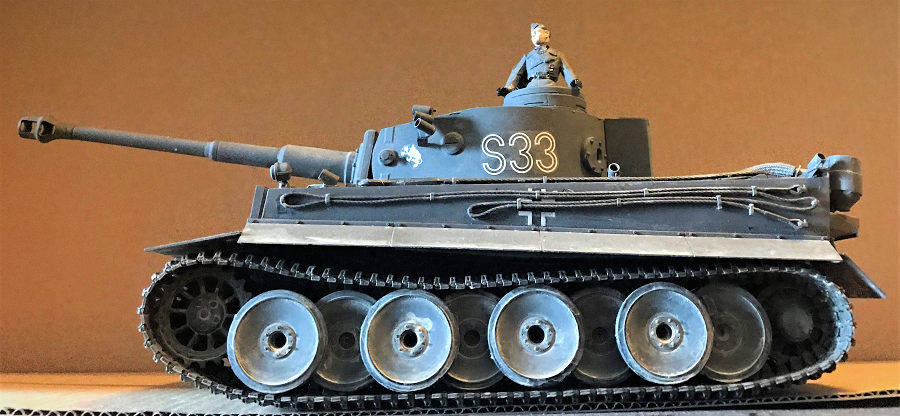
Tamiya 1/35 Tiger I (early)
| KIT #: | 35216 |
| PRICE: | $45.00 |
| DECALS: | Six options |
| REVIEWER: | Donald Zhou |
| NOTES: |
Advantages: Great details, lots
of marking and plenty of options. Disadvantages: Dust screens missing, details simplified, rubber band tracks |

| HISTORY |
The original design that eventually birthed the Tiger was VK 30.01 and 36.01. These designs were eventually evolved into what is the Tiger I. The name was given by Dr. Ferdinand Porsche and the Roman numerical “I” was given after the Tiger II (King Tiger) was produced. The weight of the tank was increased from the original 36 tons to 45, eventually ballooned well over 50 tons to a fully loaded 56 tons. Armor was stabilized at the front with 110mm at the mantlet and 100mm at the hull. Due to armor quality, and Tigers used the highest armor quality at the time, equivalent to 150mm at the mantlet! This makes the tank almost impervious to any allied tank gun at the time up front. Side armor was increased to 80mm at the side and 60mm at the rear, offering greater protection than the Panther and is the main reason for the tank super heavy weight. Main armament consists of a KwK 36 88mm cannon and two MG34 machine guns, one mounted co-axle with the main cannon, the other at the ball mounted hull position in front of the radio operator. Eventually, a third one was also mounted at top of the commander cupola to defend against aircraft.
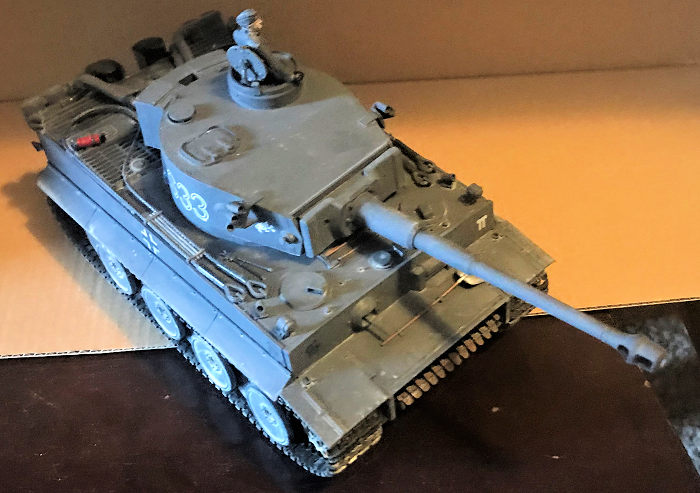 Main engine was the
Maybach 12-cylinder HL
210 P45 developing 485 kW (650 hp) at 3,000 rpm. Again, this engine is very
reliable and require very little maintenance. However, it was never ever
designed to power this 56 ton monster and proved unreliable instead, especially
if maintenance wasn’t constantly pulled on it. All Initial and Early production
of the Tigers used this engine. From the Mid Production version on, the Maybach
HL 230 P45, a 23.095 liter (1409 cu.in.) engine developing 521 kW (700 hp) at
3,000 rpm was used instead. The biggest difference are the air filters. The
earlier engine used three small filters on top of the engine while the later
version used two large ones. This improved the situation a little but still, the
tank was woefully underpowered. Initial and Early versions also had the Pfeifel
air filtration system. This consisted of two air filters on the back of the tank
and series air tubes on the rear deck. However, by mid production variants, this
system was eliminated. The tank also featured interleaved road wheels like the
Panther and is far more involving and complex. This plus the super high quality
of armor meant the tank was very hard to produce and over engineered. The
complex interleaved road wheels tends to freeze and stuck in mud or Rus
Main engine was the
Maybach 12-cylinder HL
210 P45 developing 485 kW (650 hp) at 3,000 rpm. Again, this engine is very
reliable and require very little maintenance. However, it was never ever
designed to power this 56 ton monster and proved unreliable instead, especially
if maintenance wasn’t constantly pulled on it. All Initial and Early production
of the Tigers used this engine. From the Mid Production version on, the Maybach
HL 230 P45, a 23.095 liter (1409 cu.in.) engine developing 521 kW (700 hp) at
3,000 rpm was used instead. The biggest difference are the air filters. The
earlier engine used three small filters on top of the engine while the later
version used two large ones. This improved the situation a little but still, the
tank was woefully underpowered. Initial and Early versions also had the Pfeifel
air filtration system. This consisted of two air filters on the back of the tank
and series air tubes on the rear deck. However, by mid production variants, this
system was eliminated. The tank also featured interleaved road wheels like the
Panther and is far more involving and complex. This plus the super high quality
of armor meant the tank was very hard to produce and over engineered. The
complex interleaved road wheels tends to freeze and stuck in mud or Rus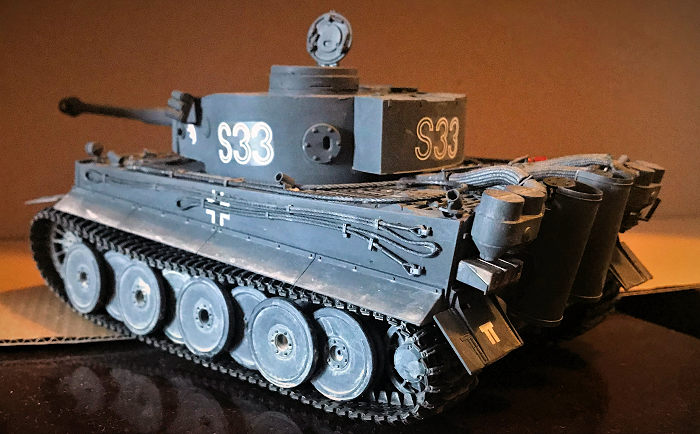 sian
winter where ice can form between them. The track was so wide that for rail
transport, the outer most road wheels must be removed and then a narrower
“travel” tracks installs and for the price of a single Tiger, 2.5 Panthers or up
to as much as 5 Panzer IV’s can be produced. All these reasons meant that only
1800-2200 Tiger I’s were ever produced before production ceased.
sian
winter where ice can form between them. The track was so wide that for rail
transport, the outer most road wheels must be removed and then a narrower
“travel” tracks installs and for the price of a single Tiger, 2.5 Panthers or up
to as much as 5 Panzer IV’s can be produced. All these reasons meant that only
1800-2200 Tiger I’s were ever produced before production ceased.
It’s really hard to quantify the Tiger despite its legendary proportions. This is especially true since the Tiger really wasn’t meant as a MBT or tank that can go really hard on the move. It has always been designed as a “breakthrough” tank. AKA, like the Mark I-V tanks of WW I, where it would go straight against an enemy’s front line, using its heavy armor and powerful gun to blast a hole through the defenses, then wreak havoc at the rear before smaller, faster tanks, such as the Panther and even the Panzer IV can take over to exploit the breakthrough. After that happens, the tank would back off to the breaker yards where it would spend the rest of the day getting its temperamental engine, running gears and the rest fixed or maintained. However, this only happened once and that was the Battle of Kursk, where the tank was rushed into battle. It performed quite well in its intended breakthrough role. However, after that, Germany was forever on the defensive until the bitter end and the tank weakness was fully shown. Despite massive successes like battle of Viller-Bocage etc that gain the tank a reputation that was really not worthy, the tanks effect on the entirety of the war was relatively minor, especially due to the small numbers of the tanks produced. In this person’s option, after Kursk, the tank should have stopped production (alongside such massive stupid heavy projects like the King Tiger, Jadttiger, Maus, Sturmtiger and maybe even the JagtPanther). The few remaining vehicles dispersed to major defensive positions, where its weaknesses was much less critical in this respect and the remaining money and resources spent on the Panther or even the Panzer IV instead!
| THE KIT |
This is actually my second run through with this kit. The original was released in 1997 and still holds up well today. I built the first one back in 2002 in San Diego before having to give it up when I had to move to China. The only major tripping points is lack of the photo-etched dust screens on the deck and the fact the tracks are single piece rubber band and there is no clear vision ports or periscopes. However, even if some of the details are simplified, the tank offers enough and have more options than most other kits and can still build up to a respectable Tiger I Early version. There are six marking options offered, a change from the one or two or at most, three markings offered in most Tamiya kits. These include a tank operated by Michael Wittman in winter camo with the famous kill markings that run the entire length of the cannon tube and several others. But the one that really caught my eye though, was tank S33…
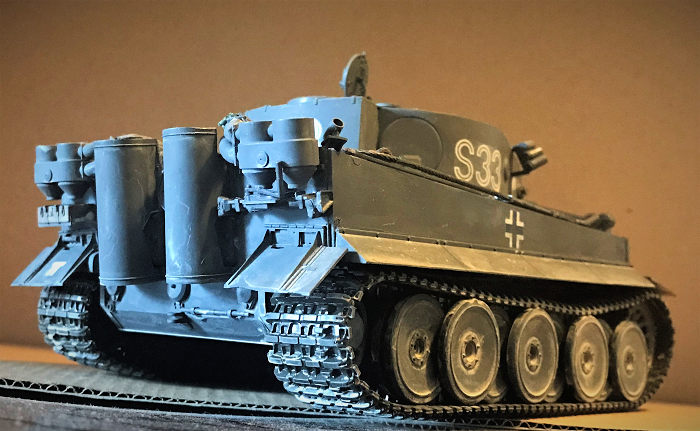 The reason why is S33 has
an upside down Chinese “Fu” or “福” marking on the front, and both sides of the
tank….The first time I saw this marking in 2002 I had to laugh…”OHH Tamiya, you
sick jokester, like a Teutonic high powered German tank would carry some Chinese
characters on them, much less one that’s upside down!!! Tamiya, you ssssssssoooo
“FUNNEH””!!!!!!!!!!!....
The reason why is S33 has
an upside down Chinese “Fu” or “福” marking on the front, and both sides of the
tank….The first time I saw this marking in 2002 I had to laugh…”OHH Tamiya, you
sick jokester, like a Teutonic high powered German tank would carry some Chinese
characters on them, much less one that’s upside down!!! Tamiya, you ssssssssoooo
“FUNNEH””!!!!!!!!!!!....
Then I found out there actually WAS a Tiger that carried the Chinese Fu or 福 marking on it…..
What………..In………….The………..World?!?!?!?!? was my first reaction upon finding out! You see, being a Chinese American, I fully understood the meaning behind that upside down “Fu”. But to have it appear on a German tank, a Tiger no less?!?!? You can see where this is going! Someone had to be a real, and I do mean a REEAAAALLLL Sino-holic to understand, much less put that marking on a Tiger! Digging deeper, it turns out, well, as you see, there are several stories about how that symbol got on a Tiger, one of the more promising is that back when the Japanese first annexed Manchuria in 1931 and Chiang Kai-Sheik went screaming for help, he actually went to the Germans to do so. This was just after Adolf Hitler took power and Germany still wasn’t allied to the Japanese yet. Few people knew this, but the Germans eventually ended up equipping several Chinese divisions with German arms and the Chinese eventually also bought several Panzer I’s. These were shattered during the Japanese invasion of the mainland but before that can happen, Chiang asked and got help in the form of several Germans who served as attaches or advisors to teach the Chinese to use German doctrine and armor. One of these was a young Captain to teach Chinese how to use their new German Panzers.
Once the new captain arrived at his new land and home, he immediately hired several Chinese to help teach him the layout of his new home, its culture and food…He supposedly ended up loving Chinese culture and was very fond of Hangzhou Fried Rice, pork strips fried with Chinese brocolinies, and spicy twice cooked pork (supposedly, upon arriving back in Germany, one of his biggest complaints was he can’t get the Chinese food he so desperately craved due to lack of ingredients)! He also quickly formed a bond with his Chinese man servant, who taught him fluent mandarin and many quirky aspects of the Chinese culture (another story said that he eventually married a daughter of a Chinese diplomat).
But all of this was not
meant to last. After signing the alliance with Italy and Japan, Germany
eventually officially pulled out of China. This where the story took two
different paths. One is which the Captain really did not want to let his friend,
close personal confidant and general brother go, so he took the Chinese man
servant with him to Germany. This, IMO, is unlikely due to the German racial
policy at the time. The second
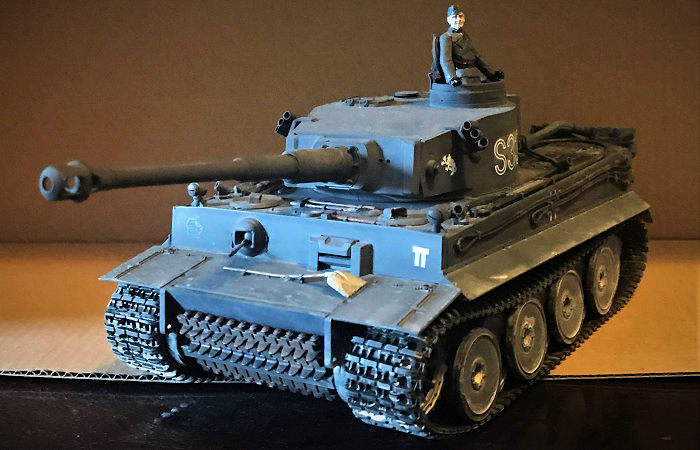 one is in which despite everything, he eventually
had to leave the man servant behind and go back to Germany, where he entered the
armored corp. and performed very well in the early part of the war. Before the
Battle of Kursk, the newly promoted man was given a brand new Tiger to command.
He quickly showed it off proudly to his family and friends. If the first story
is to be believed, the Chinese man servant quickly went and grabbed a can of
paint and drew an upside down Fu on the front, opposite side of the unit
marking, and then the front of either side too as good luck charms. Even if the
first part isn’t true, the German man himself at this point is a huge sino-holic
and could’ve done that himself on his tank (or his Chinese wife if that story is
to believed) so yeah, there is that Tiger with the Chinese upside down Fu
marking!
one is in which despite everything, he eventually
had to leave the man servant behind and go back to Germany, where he entered the
armored corp. and performed very well in the early part of the war. Before the
Battle of Kursk, the newly promoted man was given a brand new Tiger to command.
He quickly showed it off proudly to his family and friends. If the first story
is to be believed, the Chinese man servant quickly went and grabbed a can of
paint and drew an upside down Fu on the front, opposite side of the unit
marking, and then the front of either side too as good luck charms. Even if the
first part isn’t true, the German man himself at this point is a huge sino-holic
and could’ve done that himself on his tank (or his Chinese wife if that story is
to believed) so yeah, there is that Tiger with the Chinese upside down Fu
marking!
But why Fu, why upside down? You see, Fu or 福 means (good) fortune in Chinese. The upside down part though, you gotta understand Chinese culture for this. You see, in Chinese, upside down or “dao” 倒, has the same pronunciation as 到, or to come, to come this way. Also, this also has the same pronunciation as 道, or path, way (same meaning as the mythical Taoism”). This is why on Chinese New Years, so many doors have an upside down Fu posted on them! It literally means, “The path of fortune will come through this door, or visit this door/house”! Thus, the upside down Fu on the Tiger means “The path of fortune (or in this case good luck) will come and visit this tank”! The original Tiger that contained the upside down “Fu” marking was painted in German/Panzer Gray, standard at the time, with white unit markings.
As it turn out though, the markings did little to bring luck to the tank. During Battle of Kursk, the tank was badly damaged and the crew, including the tank commander, was badly wounded. The tank though, was eventually fixed up and given to a new commander and this is what is shown in the kit marking, overall standard Dark Yellow with mottled dark green stripes. The upside down Fu markings though, was kept since even though the new commander didn’t understood Chinese, he though the markings were Teutonic symbol of power and promptly kept them….This time however, well…Umm….The tank was so completely destroyed it was a total write off and the crew died alongside it too………………………….So much for luck brought about by those upside down Fu markings!
As you may guessed now. After finding out, I had to (eventually) get another one to dole the Tiger up in this very unusual marking….This is probably the only tank in European Front, Allied or Axis that had a Chinese symbol on it! Although, I did decide to paint the tank as it first appeared with the upside down Fu marking, i.e. in overall standard German Gray instead.
| CONSTRUCTION |
It’s a Tamiya kit…..So umm yeah….Took only about 10 hours total on and off to make this.
The only big tripping point
is the running gear. This is no fault of the kit. You want to build a Tiger? You
have to deal with this since the real thing was THAT complex and headache
inducing! I mean, whoever thought it was a good idea of equipping 24 road wheels
per side, 48 total on a tank need to be taken out back and shot! Read and follow
the instr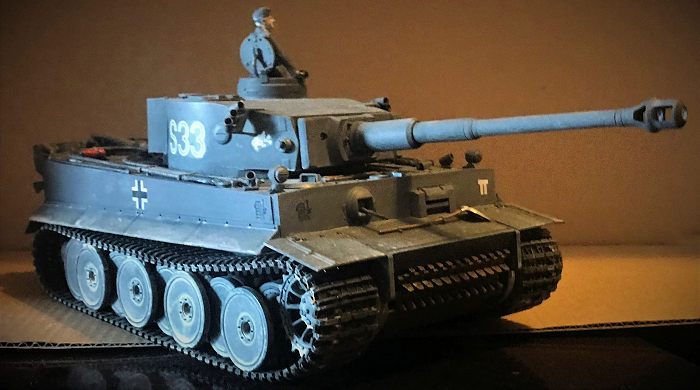 uctions carefully!
uctions carefully!
The first thing to notice is that the suspension arms on one side faces forward, towards the front of the tank while the other side faces rearward, towards the stern! There are quite a few newbie modelers, while making German Panthers and/or Tigers put the arms all toward the rear. Don’t really blame them cause every other tank other than the Germans all have the arms facing backwards!
The biggest
headache are the road wheels. Not only are there too many, you also have to
really follow the instruction since if you mess up, there is a great chance the
rest of the road wheels will not be able to be assembled! Again, you have to put
the innermost road wheels first. This means the even number wheels, 2, 4, 6, 8,
arms needs to receive the first batch of road wheels. Then the inner most wheels
on the odd number, 1, 3, 5, 7 are put in next. Next are the outer most wheels on
the even arms. Only after that are the odd number arms outer wheels are
assembled. And no, to throw even more confusion into the matter, the German made
sure at least one set of wheels has two road wheels sandwiched together to make
one wheel, and one more confusion grenade, these sandwiched wheels are put in
OPPOSITE sequence from one arm to the next! What this mean? It means all the odd
number arms, the inner most wheels are the
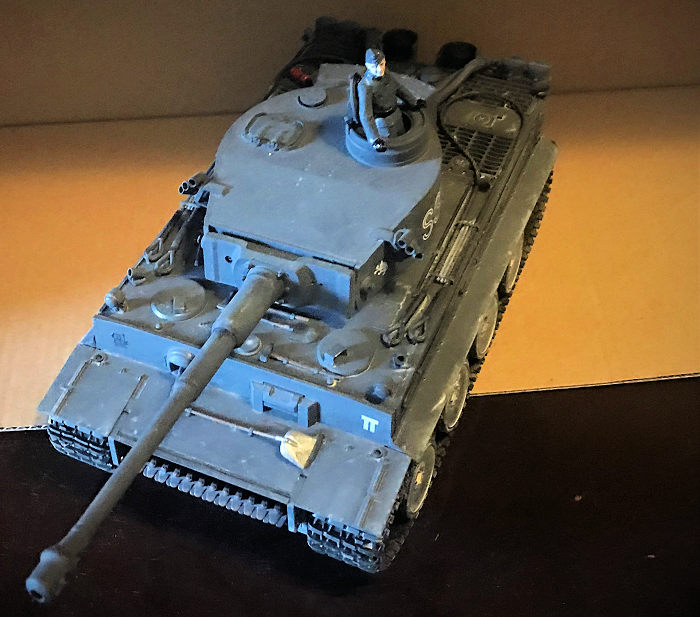 sandwich type while the even number
arms has the OUTER wheels as the sandwich types! Confused yet?!?!?!? If you are,
just remember to follow the instructions TO THE LETTER! Again, there is no way
around this since the real thing WAS that confusing! After finishing this and
looking at the confusing jumbled mess of road wheels, I had to shake my head. No
wonder some German crews attempted to shoot themselves with their Lugers when it
came time to fix the wheels! Example, just to get the last road wheel on arm 2,
you had to basically remove 6, that’s SIX other road wheels just to reach it!
Imagine doing this while the gears are clogged with mud or frozen to solid steel
in the dreaded Russian winter! NOT FUN!
sandwich type while the even number
arms has the OUTER wheels as the sandwich types! Confused yet?!?!?!? If you are,
just remember to follow the instructions TO THE LETTER! Again, there is no way
around this since the real thing WAS that confusing! After finishing this and
looking at the confusing jumbled mess of road wheels, I had to shake my head. No
wonder some German crews attempted to shoot themselves with their Lugers when it
came time to fix the wheels! Example, just to get the last road wheel on arm 2,
you had to basically remove 6, that’s SIX other road wheels just to reach it!
Imagine doing this while the gears are clogged with mud or frozen to solid steel
in the dreaded Russian winter! NOT FUN!
The rest of the kit are a cinch. Just be aware though, there are a lot of options since the markings on offer are all a little different to each other. Again, this is real life since the Tiger, alongside the Panther, was thrown into the fray way too early, before all the details were frozen and settled. And as the years went by and various tanks started to be retrofitted or upgrade at the factory, in the field or whatever the crews can get their hands on, things got even more confusing so start marking down what you need before you use the wrong parts. For the S33 marking I’m making, since this will be a Kursk machine, thus very early version of the Tiger, I elected to use the early version mantlet, early version Pfilefil air filters and the big snow shovel on top of the transmission casing. I decided to leave the turret spare tracks off but use the lower hull spare tracks instead. The rest of the assembly and the turret were quickly bought up to speed. Most of the assembly time dealt with the wheels and the arms, the rest was easy! I left of the tracks and all the pioneer tools etc. To the paint shop we go.
| COLORS & MARKINGS |
Painting is Standard
German/Panzer Grey. This was sprayed using Tamiya German Grey paint. Afterward,
the markings were put on before weathering can begin. I decided to minimize the
weathering. There are dirty spots since tanks are dirty things, especially the
running gears and dust was added to front and the top. To tone the grey down a
bit, Apple Barrel “Concrete Grey” was added to lighten the grey up a bit.
Afterwards, the tracks are assembled and added. Had to superglue the top to the
wheels since the real thing has the tracks mostly resting on top of the wheels
on the top rung. This was quickly done since the weathering session was so
sh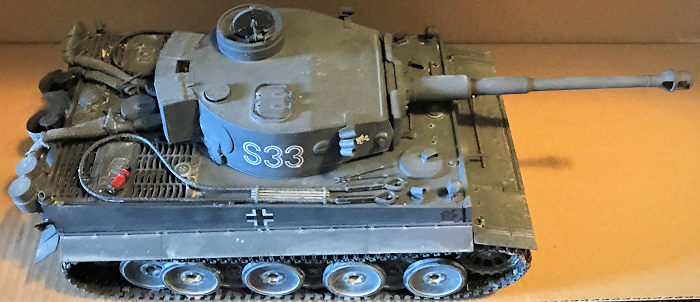 ort. I decided to keep this tank clean since 1. I don’t want the weathering to
cover the “Fu” markings and 2. I decided my Rye Field Model Mid production with
the interior (sigh, why do I keep on torture myself with kits that has over 1000
parts?!?!?!?) and Dragon Late version will be the “dirty puppies”. This is to
denote the “new” nature of the Early production variant, as if it’s just entered
service, which is true for S33 since it was basically a factory fresh machine
when it first headed out.
ort. I decided to keep this tank clean since 1. I don’t want the weathering to
cover the “Fu” markings and 2. I decided my Rye Field Model Mid production with
the interior (sigh, why do I keep on torture myself with kits that has over 1000
parts?!?!?!?) and Dragon Late version will be the “dirty puppies”. This is to
denote the “new” nature of the Early production variant, as if it’s just entered
service, which is true for S33 since it was basically a factory fresh machine
when it first headed out.
The rest consists of all the pioneering tools. Be sure what goes where since Early production version had the tool placement different than mid and late versions. The tow cables were painted in gunmetal and dusted and placed on the tank. The rear end fire extinguisher was painted in red, with black holding bands and nozzle. Finally, the commander figure was painted in Germany Grey uniform, flesh face and black and silver details before putting it into his cupola. Model done!
| CONCLUSIONS |
Another simple easy Tamiya kit! It’s surprising this kit is now over 20 years old but still can rank up there with the best of them! Yes, it’s not a Dragon kit, but then again, it does not have over 1000 parts, including several hundred multi piece single track assembly either so you get what you pay for! Not only that, the decal sheet has the missing elephant symbol that I need to assemble the Rye Field Model Mid-Production Tiger with the interior (sigh, another kit with over 1000 parts) as Otto Carius (not as famous as Michael Wittmann, but this man has more kills than him) Tiger. All in all, highly recommended as any other Tamiya kits!
May 2020
Copyright ModelingMadness.com.
If you would like your product reviewed fairly and fairly quickly, please
contact
the editor or see other details in the
Note to
Contributors.
Back to the Main Page
Back to the Review
Index Page
Back to the Previews Index Page